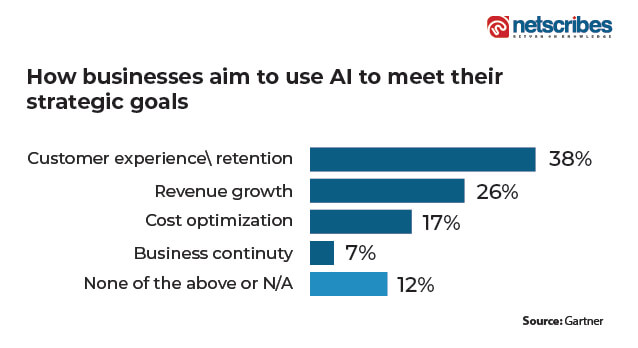Highlights
- Explore the profound impact of enhanced personalization through AI and machine learning, showcasing industry leaders like Amazon and illustrating success through case studies from companies such as Netflix and Spotify.
- Uncover the significant influence of voice commerce, underscoring its adoption by 40% of US internet users.
- Check out the revolutionary role of generative AI in product management and customer care, emphasizing its applications in inventory management.
In the fast-paced realm of e-commerce, staying ahead of emerging trends is critical for businesses seeking sustained success and relevance in the competitive market. The ability to adapt to new technologies not only enhances operational efficiency but also provides a superior customer experience. As we delve into the trends shaping 2024, let’s explore the transformative landscape of ecommerce technology.
1. Enhanced personalization and customer experience
AI and machine learning algorithms have revolutionized this space as one of the top ecommerce technology trends in 2024, particularly in terms of personalization. Amazon, a frontrunner in this space, utilizes advanced recommendation engines powered by AI. These algorithms analyze user behavior, purchase history, and preferences to offer highly personalized product suggestions, creating a more engaging and customized shopping experience for each user.
Numerous case studies demonstrate the success of personalized shopping experiences in e-commerce. Companies like Netflix and Spotify have mastered the art of content recommendation, leveraging machine learning to understand user preferences and curate personalized suggestions. These examples showcase the potential for e-commerce businesses to enhance customer engagement and satisfaction through intelligent personalization strategies
2. Voice commerce continues to resonate
Approximately 40% of US internet users use a voice assistant every month. E-commerce brands are compelled to prioritize the optimization of their websites for voice commerce to remain at the forefront of industry trends.
Certain digital technologies make a quiet entrance, gradually becoming ingrained in our daily lives. This makdes voice technology is a prime example of an impactful ecommerce technology trend in 2024. Initially gaining traction as developers and users expanded their perception of sound in multi-sensory engagement, voice activation quietly evolved. Google played a pivotal role in popularizing it with their “speech-to-text” feature integrated into search functionality. What was once a subtle bleeding-edge technology, reminiscent of OnStar, soared to widespread adoption with the introduction of Google Assistant, Siri, Alexa, and similar voice-activated platforms.
Consider a voice-commerce shopping scenario, where a buyer audibly requests items to be added to their cart, places the order seamlessly through an integrated system, and receives confirmation through both voice and visual outputs. While the availability of the requested item is not guaranteed, voice commerce allows for hands-free ordering precisely when needed. This not only saves time but also minimizes the potential for order errors through complete automation of the ordering process.

3. Generative AI in product management
Generative AI is revolutionizing product management by enhancing efficiency in prototype development and ensuring products align closely with customer preferences. Beyond these benefits, it assists product managers in identifying emerging product trends by analyzing diverse sources, including competitive product documentation, industry whitepapers, and customer feedback.
Additionally, generative AI proves invaluable in staying ahead of market needs, utilizing non-traditional data sources such as social media posts, search engine requests, blogs, and online articles. To maximize the effectiveness of generative AI tools, it’s crucial to ensure they are trained on diverse datasets and monitored for biases. Implementing policies guided by diverse leaders and subject-matter experts helps regulate the data input into generative AI applications. For organizations facing data limitations, investing in synthetic data becomes a strategic solution to address gaps in training generative AI models.
Related reading: Revolutionizing e-commerce: How catalog AI is transforming product listings

4. Generative AI in customer care and inventory management
Generative AI emerges as a powerful cognitive assistant in customer care. By this it offers contextual guidance derived from conversation history, sentiment analysis, and call center transcripts. This technology enhances the customer experience by providing tailored support, ultimately fostering loyalty and conferring a competitive edge. Beyond customer care, generative AI proves instrumental in optimizing inventory support.
By leveraging historical sales data and external factors, Generative AI aids in more accurate demand predictions. This helps mitigate risks of stockouts and excess inventory. Automation of inventory replenishment and allocation further streamlines retail operations, contributing to enhanced overall performance. In both customer care and inventory management, generative AI emerges as a transformative force, elevating efficiency and delivering personalized solutions.
5. Advanced applications in AR and VR
Pioneering brands like IKEA leverage AR for virtual furniture placement, while Shopify integrates VR for immersive shopping experiences. Such innovations redefine consumer interactions, setting the tone for the industry.
The rise of Augmented Reality (AR) and Virtual Reality (VR) technologies is reshaping the ecommerce landscape. Brands like IKEA have embraced AR for virtual furniture placement. This allows customers to visualize products in their own spaces before making a purchase. Similarly, e-commerce platforms like Shopify are integrating VR to provide immersive shopping experiences. These offer customers a virtual storefront to explore and interact with products.
Leading brands across various industries are at the forefront of AR/VR adoption. Sephora, a renowned beauty retailer, utilizes AR for virtual makeup try-ons. In this manner they enable customers to see how different products will look on their faces. This not only enhances the online shopping experience but also mitigates uncertainties associated with purchasing beauty products online. These examples underscore the transformative potential of AR and VR in redefining consumer interactions and expectations in the e-commerce space.
In conclusion, the transformative trends outlined for 2024 showcase the evolving nature of e-commerce and technology trends in this space. Embracing innovation, as demonstrated by industry leaders, is paramount for businesses seeking to navigate the dynamic future of e-commerce successfully. To stay competitive by continually monitoring e-commerce industry developments and adopting agile strategies to capitalize on emerging opportunities, contact us.






